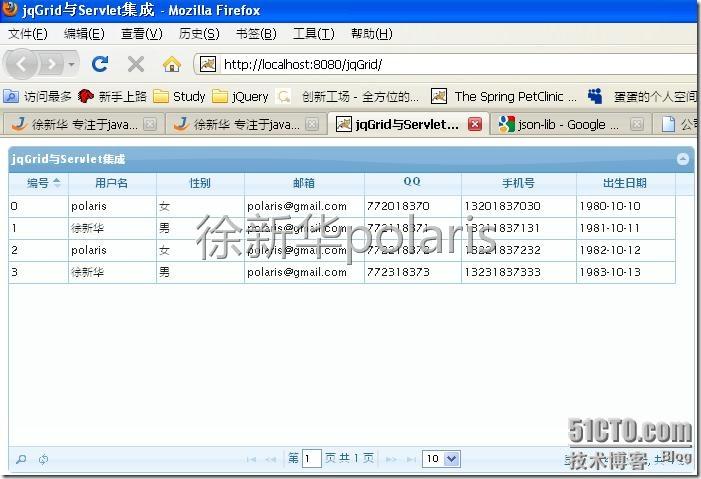http://polaris.blog.51cto.com/1146394/264340
jQuery学习之:jqGrid表格插件——从servlet获得数据 2010-01-12 19:15:02
原创作品,允许转载,转载时请务必以超链接形式标明文章 原始出处 、作者信息和本声明。否则将追究法律责任。http://polaris.blog.51cto.com/1146394/264340
在我的jqGrid第一个demo中,没有涉及到任何与服务端的交互:数据是从自己定义的一个固定数组中得到的。当然,实际应用中不可能会这么做。在 jqGrid官方网站上提供的demo,服务器端全部是PHP,在网上找了很久,也没有找到写的完整详细的从JSP/Servlet获得数据的例子。下面是我写的一个从Servlet获得数据的例子,希望对初学者有点帮助。
jqGrid支持的好几种数据类型,现在使用比较多的是JSON。本文中也采用这种数据类型。另外,本文使用了json-lib,因而您也需要下载json-lib.jar,可以到http://json-lib.sourceforge.net/上下载,且该网站上有关于json-lib的详细介绍与使用。感兴趣的可以阅读。
jqGrid支持的好几种数据类型,现在使用比较多的是JSON。本文中也采用这种数据类型。另外,本文使用了json-lib,因而您也需要下载json-lib.jar,可以到http://json-lib.sourceforge.net/上下载,且该网站上有关于json-lib的详细介绍与使用。感兴趣的可以阅读。
下面开始我们的jqGrid与Servlet之旅吧。
1、效果图:
这个跟第一个Demo看起来没有什么区别。的确没啥区别。只是这次的数据是从服务器端获取的。
2、代码及解释
HTML代码:
<body>
<table id="gridTable"></table>
<div id="gridPager"></div>
</body>
<table id="gridTable"></table>
<div id="gridPager"></div>
</body>
JavaScript代码:
$(function()
{
$("#gridTable").jqGrid({
url:'jqGridServlet',
datatype: "json",
height: 250,
colNames:['编号','用户名', '性别', '邮箱', 'QQ','手机号','出生日期'],
colModel:[
{name:'id',index:'id', sorttype:"int"},
{name:'userName',index:'userName',
{name:'gender',index:'gender',
{name:'email',index:'email', ;string"},
{name:'QQ',index:'QQ', ;
{name:'mobilePhone',index:'mobilePhone', ;
{name:'birthday',index:'birthday', sorttype:"date"}
],
sortname:'id',
sortorder:'asc',
viewrecords:true,
rowNum:10,
rowList:[10,20,30],
jsonReader:{
repeatitems : false
},
pager:"#gridPager",
caption: "jqGrid与Servlet集成"
}).navGrid('#gridPager',{edit:false,add:false,del:false});
})
{
$("#gridTable").jqGrid({
url:'jqGridServlet',
datatype: "json",
height: 250,
colNames:['编号','用户名', '性别', '邮箱', 'QQ','手机号','出生日期'],
colModel:[
{name:'id',index:'id', sorttype:"int"},
{name:'userName',index:'userName',
{name:'gender',index:'gender',
{name:'email',index:'email', ;string"},
{name:'QQ',index:'QQ', ;
{name:'mobilePhone',index:'mobilePhone', ;
{name:'birthday',index:'birthday', sorttype:"date"}
],
sortname:'id',
sortorder:'asc',
viewrecords:true,
rowNum:10,
rowList:[10,20,30],
jsonReader:{
repeatitems : false
},
pager:"#gridPager",
caption: "jqGrid与Servlet集成"
}).navGrid('#gridPager',{edit:false,add:false,del:false});
})
JavaScript的代码跟之前有几个地方不一样。其中,url:'jqGridServlet'的jqGridServlet是Servlet的 url-pattern;datatype: "json"表示服务器端需要返回json数据;jsonReader:{repeatitems : false}则是为了后台处理数据方便而设置,具体意思见下面Java代码的注释。
Java代码:
package com.polaris.jqgrid.servlet;
import java.io.IOException;
import javax.servlet.ServletException;
import javax.servlet.http.HttpServlet;
import javax.servlet.http.HttpServletRequest;
import javax.servlet.http.HttpServletResponse;
import net.sf.json.JSONArray;
import net.sf.json.JSONObject;
/**
* 该Servlet向客户端返回一个json对象。为了简便,数据不是从数据库获得的。
* jqGrid默认期望返回的json对象格式要求如下:
* {"page":"1","total":"2","records":"13",
* "rows":[
* {id:"1",cell:["1","polaris","男","polaris@gmail.com","772618379","18329382732","1985-10-2"]},
* {id:"2",cell:["2","张三","女","zhangsan@163.com","272618382","15329382732","1986-10-12"]},
* {id:"3",cell:["3","王五","女","wangwu@yahoo.com","172635372","13329389832","1987-12-21"]},
* {id:"4",cell:["4","赵六","男","zhaoliu@sina.com","372618332","18929343731","1988-09-22"]}
* ]
* }
* 当然,在js中,可以通过jqGrid的jsonReader属性来修改默认格式
* 因为默认的格式,rows的数据要求顺序不能变,且每个字段都得有值(空也得有"")。因而,
* 在jsonReader中定义repeatitems : false。这样,rows就变成了:
* "rows":[
* {id:"1",userName:"polaris",gender:" 男",email:"polaris@gmail.com",QQ:"772618379",mobilePhone:"18329382732",birthday:"1985-10-2"]},
* {id:"2",userName:"徐新华",gender:" 男",email:"xh.xu@163.com",QQ:"272618382",mobilePhone:"15329382732",birthday:"1986-10-12"]},
* {id:"3",userName:"王五",gender:" 女",email:"wangwu@yahoo.com",QQ:"172635372",mobilePhone:"13329389832",birthday:"1987-12-21"]},
* {id:"4",userName:"赵六",gender:" 女",email:"zhaoliu@sina.com",QQ:"372618332",mobilePhone:"18929343731",birthday:"1988-09-22"]}
* ]
* @author xuxinhua
*
*/
public class JqGridForJSONServlet extends HttpServlet
{
private static final long serialVersionUID = 132383828833L;
@Override
public void doGet(HttpServletRequest req, HttpServletResponse resp)
throws ServletException, IOException {
// 定义返回的数据类型:json,使用了json-lib
JSONObject jsonObj = new JSONObject();
// 根据jqGrid对JSON的数据格式要求给jsonObj赋值
jsonObj.put("page", 1); // 当前页
jsonObj.put("total", 1); // 总页数
jsonObj.put("records", 4); // 总记录数
// 定义rows,存放数据
JSONArray rows = new JSONArray();
// 放入4条数据
for(int i=0;i<4;i++)
{
// 存放一条记录的对象
JSONObject cell = new JSONObject();
cell.put("id", i);
if(i%2==0)
{
cell.put("userName", "polaris");
cell.put("gender", "女");
}
else
{
cell.put("userName", "徐新华");
cell.put("gender", "男");
}
cell.put("email", "polaris@gmail.com");
cell.put("QQ", "772"+i+"1837"+i);
cell.put("mobilePhone", "132"+i+"1837"+i+"3"+i);
cell.put("birthday", "198"+i+"-10-"+"1"+i);
// 将该记录放入rows中
rows.add(cell);
}
// 将rows放入json对象中
jsonObj.put("rows", rows);
// 自控制台打印输出,以检验json对象生成是否正确
System.out.println("要返回的json对象:\n" + jsonObj.toString());
// 设置字符编码
resp.setCharacterEncoding("UTF-8");
// 返回json对象(通过PrintWriter输出)
resp.getWriter().print(jsonObj);
}
@Override
public void doPost(HttpServletRequest req, HttpServletResponse resp)
throws ServletException, IOException {
doGet(req,resp);
}
}
import java.io.IOException;
import javax.servlet.ServletException;
import javax.servlet.http.HttpServlet;
import javax.servlet.http.HttpServletRequest;
import javax.servlet.http.HttpServletResponse;
import net.sf.json.JSONArray;
import net.sf.json.JSONObject;
/**
* 该Servlet向客户端返回一个json对象。为了简便,数据不是从数据库获得的。
* jqGrid默认期望返回的json对象格式要求如下:
* {"page":"1","total":"2","records":"13",
* "rows":[
* {id:"1",cell:["1","polaris","男","polaris@gmail.com","772618379","18329382732","1985-10-2"]},
* {id:"2",cell:["2","张三","女","zhangsan@163.com","272618382","15329382732","1986-10-12"]},
* {id:"3",cell:["3","王五","女","wangwu@yahoo.com","172635372","13329389832","1987-12-21"]},
* {id:"4",cell:["4","赵六","男","zhaoliu@sina.com","372618332","18929343731","1988-09-22"]}
* ]
* }
* 当然,在js中,可以通过jqGrid的jsonReader属性来修改默认格式
* 因为默认的格式,rows的数据要求顺序不能变,且每个字段都得有值(空也得有"")。因而,
* 在jsonReader中定义repeatitems : false。这样,rows就变成了:
* "rows":[
* {id:"1",userName:"polaris",gender:" 男",email:"polaris@gmail.com",QQ:"772618379",mobilePhone:"18329382732",birthday:"1985-10-2"]},
* {id:"2",userName:"徐新华",gender:" 男",email:"xh.xu@163.com",QQ:"272618382",mobilePhone:"15329382732",birthday:"1986-10-12"]},
* {id:"3",userName:"王五",gender:" 女",email:"wangwu@yahoo.com",QQ:"172635372",mobilePhone:"13329389832",birthday:"1987-12-21"]},
* {id:"4",userName:"赵六",gender:" 女",email:"zhaoliu@sina.com",QQ:"372618332",mobilePhone:"18929343731",birthday:"1988-09-22"]}
* ]
* @author xuxinhua
*
*/
public class JqGridForJSONServlet extends HttpServlet
{
private static final long serialVersionUID = 132383828833L;
@Override
public void doGet(HttpServletRequest req, HttpServletResponse resp)
throws ServletException, IOException {
// 定义返回的数据类型:json,使用了json-lib
JSONObject jsonObj = new JSONObject();
// 根据jqGrid对JSON的数据格式要求给jsonObj赋值
jsonObj.put("page", 1); // 当前页
jsonObj.put("total", 1); // 总页数
jsonObj.put("records", 4); // 总记录数
// 定义rows,存放数据
JSONArray rows = new JSONArray();
// 放入4条数据
for(int i=0;i<4;i++)
{
// 存放一条记录的对象
JSONObject cell = new JSONObject();
cell.put("id", i);
if(i%2==0)
{
cell.put("userName", "polaris");
cell.put("gender", "女");
}
else
{
cell.put("userName", "徐新华");
cell.put("gender", "男");
}
cell.put("email", "polaris@gmail.com");
cell.put("QQ", "772"+i+"1837"+i);
cell.put("mobilePhone", "132"+i+"1837"+i+"3"+i);
cell.put("birthday", "198"+i+"-10-"+"1"+i);
// 将该记录放入rows中
rows.add(cell);
}
// 将rows放入json对象中
jsonObj.put("rows", rows);
// 自控制台打印输出,以检验json对象生成是否正确
System.out.println("要返回的json对象:\n" + jsonObj.toString());
// 设置字符编码
resp.setCharacterEncoding("UTF-8");
// 返回json对象(通过PrintWriter输出)
resp.getWriter().print(jsonObj);
}
@Override
public void doPost(HttpServletRequest req, HttpServletResponse resp)
throws ServletException, IOException {
doGet(req,resp);
}
}
请注意看该类的详细注释。
web.xml
<servlet>
<servlet-name>jqGridServletForJson</servlet-name>
<servlet-class>com.polaris.jqgrid.servlet.JqGridForJSONServlet</servlet-class>
</servlet>
<servlet-mapping>
<servlet-name>jqGridServletForJson</servlet-name>
<url-pattern>/jqGridServlet</url-pattern>
</servlet-mapping>
<servlet-name>jqGridServletForJson</servlet-name>
<servlet-class>com.polaris.jqgrid.servlet.JqGridForJSONServlet</servlet-class>
</servlet>
<servlet-mapping>
<servlet-name>jqGridServletForJson</servlet-name>
<url-pattern>/jqGridServlet</url-pattern>
</servlet-mapping>
3、部署运行
导入必须的Jar包(记得导入json-lib依赖的jar包)。将工程打包部署到tomcat下,运行tomcat,在浏览器中访问写的jsp 页面,如:http://localhost:8080/jqGrid/jqGrid_servlet.jsp,回车会出现效果图的效果。
总结:
可以看出,jqGrid集成Servlet还是很简单的,就jqGrid而言,它只需要请求一个Servlet,并设置期望返回的数据类型即可。而对于Servlet而言,这需要根据jqGrid期望返回的数据类型而定,通常都会选择json数据格式,因而,Servlet主要就是构造json数据,我们可以根据json的语法要求构建,然而,那样比较繁琐,会有很多的“{}"之类的,且不清晰,容易出错。而json-lib则是一个不错的选择,因为这时操作的只是Java对象,构建json很容易,结构清晰不容易出错。因而推荐采用。
如有问题,请留言;写的不好的还请指正。敬请期待jqGrid与struts2的集成。
由于很多人问我要例子的源代码,polaris也都发给了大家,然而有时候很晚才看到,发的会有点晚。鉴于此,特提供下载polaris的jqGrid的例子代码,谢谢大家的支持!
可以到:http://www.beijixing001.com/?p=406文章结尾下载我的例子代码。
本文出自 “徐新华polaris” 博客,请务必保留此出处http://polaris.blog.51cto.com/1146394/264340
